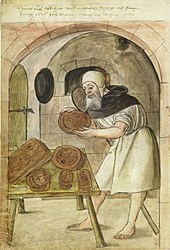Gingerbread baker
A gingerbread baker ( Lebzelter , Lebküchler , Lebküchner , Pfefferküchler ) is a specialized baker who makes gingerbread .
In the past, the production of gingerbread was a different craft or trade than that of the other bakers. Until October 3, 1990 , the Pfefferküchler was a craft occupation in the GDR. Eight years later, the Ministry of Economics resumed training as a baker specializing in pepper cake.
history
In the Middle Ages, gingerbread was mainly produced in monasteries and mansions. In the cities and markets that were gaining in importance, the Lebzel people took on this task, for which they organized their own guilds .
Since honey was the most important component of gingerbread, the gingerbread makers also dealt with the trade and processing of honey in the early modern period . They bought honey and beeswax from farmers or had them impen (= look after) their own beehives for a fee . Condition for the development of the gingerbread was in terms of honey production, the transition from Zeidlerei (honey collecting wild bees) for rural beekeeping .
Lebzelter had the right Met to boil and sell to licensed guest houses, bake gingerbread and candles to pour or pull. Gingerbreads and candles were also sold in their own shops, and some Lebzelter also had their own licensing rights .
Lebzelterei was a lucrative trade due to the high commercial value of honey at the time: A Traunsteiner Lebzelter had a good living with an inventory of 50 pounds of honey, a bucket of mead, "several pieces of wax" and a chest filled with gingerbread. According to contemporary sources, 21 pounds of honey was worth six suckling pigs in 1667 .
In the 19th century, gingerbread was gradually removed by several changes of the economic basis: State trade regulations replaced the old guild rules by using cheap beet sugar the emerging made confectionery to Lebzeltern competition, beeswax was paraffin substituted , beer replaced wine and mead as a popular drink and the farmers went over to marketing the honey on their own.
Examples
The Nuremberg gingerbread, the Basler Leckerli, whose surface was marbled with vanilla sugar, the “Karlsbader”, coated with an egg white glaze, the “Pressburger”, sprinkled with almond sticks and those from Thorn and Danzig became famous. " Kastner " and "Ischler Lebkuchen" are well-known brands in Austria .
literature
- Felix Manzenreiter: Kastner. Bad Leonfelden. Lebzelter for five centuries. Ried im Innkreis 2001, 144 pages (history of the Lebzelterei in general and the company Franz Kastner GmbH in Bad Leonfelden in particular).
- Gilbert Trathnigg: From the Welser Lebzelterei. In: Yearbook of the Musealverein Wels 1956. Wels 1956, pp. 65–89, online (PDF) in the forum OoeGeschichte.at (history of Lebzelterei in Upper Austria in general and in the city of Wels in particular).
Individual evidence
- ↑ zeit.de 2015
- ↑ Frank Muck: Wooden toy maker and pepper cake. Unknown professions from the east . In: Deutsche Handwerks Zeitung . The business newspaper for medium-sized companies. Holzmann Medien, Bad Wörishofen November 7, 2014 ( deutsche-handwerks-zeitung.de [accessed on December 27, 2014] on the subject of “25 Years Fall of the Wall”).
- ↑ Dietmar Sehn: Christmas in Saxony . Sutton Verlag, 2013, ISBN 978-3-95400-202-3 , Die Pfefferkuchenstadt Pulsnitz, p. 35–36 ( limited preview in Google Book search).
- ↑ a b Manzenreiter, p. 12.
- ↑ Manzenreiter, p. 75: In Upper Austria "by 1850 more than 50 sugar bakeries made it difficult for the roughly equal number of gingerbread factories to survive".
- ↑ Rudi Palla: Lexicon of the lost professions. Eichborn 1998, ISBN 3821844914 , keyword “Lebzelter”, p. 188.
